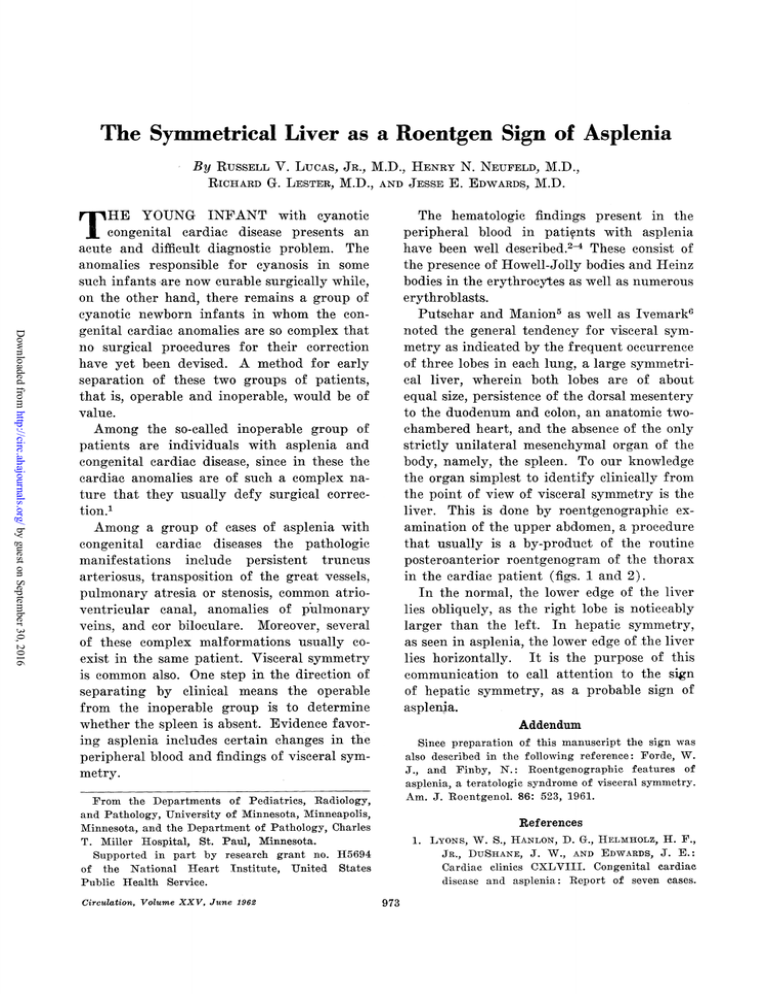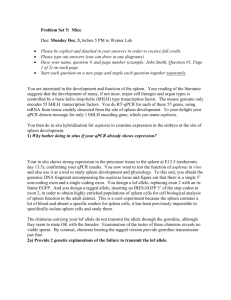
The Symmetrical Liver
as a
Roentgen Sign of Asplenia
By RUSSELL V. LUCAS, JR., M.D., HENRY N. NEUFELD, M.D.,
RICHARD G. LESTER, M.D., AND JESSE E. EDWARDS, M.D.
Downloaded from http://circ.ahajournals.org/ by guest on September 30, 2016
THE YOUNG INFANT with cyanotic
congenital cardiac disease presents an
acute and difficult diagnostic problem. The
anomalies responsible for eyanosis in some
such infants are now curable surgically while,
on the other hand, there remains a group of
eyanotic newborn infants in whom the congenital cardiac anomalies are so complex that
no surgical procedures for their correction
have yet been devised. A method for early
separation of these two groups of patients,
that is, operable and inoperable, would be of
value.
Among the so-called inoperable group of
patients are individuals with asplenia and
congenital cardiac disease, since in these the
cardiac anomalies are of such a complex nature that they usually defy surgical correction.'
Among a group of cases of asplenia with
congenital cardiac diseases the pathologic
manifestations include persistent truncus
arteriosus, transposition of the great vessels,
pulmonary atresia or stenosis, common atrioventricular canal, anomalies of pulmonary
veins, and cor biloculare. Moreover, several
of these complex malformations usually coexist in the same patient. Visceral symmetry
is common also. One step in the direction of
separating by clinical means the operable
from the inoperable group is to determine
whether the spleen is absent. Evidence favoring asplenia includes certain changes in the
peripheral blood and findings of visceral symmetry.
The hematologic findings present in the
peripheral blood in pativnts with asplenia
have been well described.2 4 These consist of
the presence of Howell-Jolly bodies and Heinz
bodies in the erythrocytes as well as numerous
erythroblasts.
Putschar and Manion5 as well as Ivemark0
noted the general tendency for visceral symmetry as indicated by the frequent occurrence
of three lobes in each lung, a large symmetrical liver, wherein both lobes are of about
equal size, persistence of the dorsal mesentery
to the duodenum and colon, an anatomic twochambered heart, and the absence of the only
strictly unilateral mesenchymal organ of the
body, namely, the spleen. To our knowledge
the organ simplest to identify clinically from
the point of view of visceral symmetry is the
liver. This is done by roentgenographic examination of the upper abdomen, a procedure
that usually is a by-product of the routine
posteroanterior roentgenogram of the thorax
in the cardiac patient (figs. 1 and 2).
In the normal, the lower edge of the liver
lies obliquely, as the right lobe is noticeably
larger than the left. In hepatic symmetry,
as seen in asplenia, the lower edge of the liver
lies horizontally. It is the purpose of this
communication to call attention to the sign
of hepatic symmetry, as a probable sign of
asplenia.
Addendum
Since preparation of this manuscript the sign was
also described in the following referenee: Forde, W.
J., and Finby, N.: Roentgenograpbic features of
asplenia, a teratologic syndrome of visceral symmetry.
Am. J. Roentgenol. 86: 523, 1961.
From the Departments of Pediatrics, Radiology,
and Pathology, University of Minnesota, Minneapolis,
Minnesota, and the Department of Pathology, Charles
T. Miller Hospital, St. Paul, Minnesota.
Supported in part by research grant no. H5694
of the National Heart Institute, United States
Public Health Service.
Circulation, Volume XXV, June 1962
References
1. LYONS, W. S., HANLON, D. G., HELMHOLZ, H. F.,
JR., DUSHANE, J. W., AND EDWARDS, J. E.:
Cardiac clinics CXLVIII. Congenital cardiac
disease and asplenia: Report of seven cases.
973
F
Downloaded from http://circ.ahajournals.org/ by guest on September 30, 2016
Figure 1
Posterooanterior roen tgenoygrams frnom three patients wcho manifested neonatal cyanosis
an(1d death in early infaincy. In each instaince at necropsy the spleen was absent, the
liver wllas neearly symmetrical, and various combiniations of complicated intracardiae
inalforornaction s were observed. Upper Left. Patie at with dcxt rocardia. Upp(er Right.
Patjent with levocardia. Fullness of the shadow caused
bqf
the left lobe of the liver is
evident in both. Lower. Two illustrations from the same patient. Lower Left. Roentgenogram miade during venous angiocardiography. The lower edge of the lef t lobc of
the liver lies prominently at a considerably more inferior level than normal. Lowver Rlight.
Film made during intravcnious pyelography in the same patient whose roentgenogram
is shown in Lower Left bringing out the features of the symmetrical liver.
974
Circulation, Volume XXV, June 1.962
SYMMETRiCALi LTVER
9 T"'
Downloaded from http://circ.ahajournals.org/ by guest on September 30, 2016
rigure 2
Thoracic organs and liver from two eyanotic infants with asplenia and multiple intracardiac anomalies. In each instance, the two lobes of the liver are of about equal size.
In the case illustrated in Left the lower edge of the left lobe is slightly superior to
that of the right lobe, but is considerably louer than the normal. In the specimen
illustrated in Right the reverse regarding the lowcer edge of the liver is trlcn in that
the lowver edge of the left lobe is slightly inferior to that on the right stde. In each
instance there were three lobes in both lungs.
Proc. Staff Meet., Mayo Clin. 32: 277, 1957.
2. WmILi, H., AND GASSER, C.: The cliniical dliagiiosis of the triad spleen agenesis, defects of
the lhear t and vessels and situs inver sus.
Et. neonatal 4: 25, 1955.
3. Busis, J. A., AND AINaIrc, L. E.: Congernital
absenice of the spleen w-ith congenital heart
disease: Report of a ca. se -with antemortem
diagnosis on the basis of hematologic morphology. Pediatrics 15: 93, 1955.
4. POLHEMUS, D. W., NxD SCHAFER, W. B.: Coln-
Circulation, Volume XXV, June 1962
genital absence of the spleeni. Pediatrics 16:
495, 1955.
5. PUTSCHAR, W. G. J., AND MANION, W. C.: Congenital absence of the spleen and associated
abnormalities. Am. J. Chini. Path. 26: 429, 1956.
6. IVEMARK, B. I.: Implicationis of agenesis of
the spleen oni the pathogeniesis of cono-truneus
aIionoalies in childhood: An analvsis of the
heart malfornmations in the spleniic agenesis
syndrome, with fourteeni niew cases. Acta
Paediat. (Uppsala), Suppl. 104, Vol. 44, 1955.
The Symmetrical Liver as a Roentgen Sign of Asplenia
RUSSELL V. LUCAS, JR., HENRY N. NEUFELD, RICHARD G. LESTER and
JESSE E. EDWARDS
Downloaded from http://circ.ahajournals.org/ by guest on September 30, 2016
Circulation. 1962;25:973-975
doi: 10.1161/01.CIR.25.6.973
Circulation is published by the American Heart Association, 7272 Greenville Avenue, Dallas, TX 75231
Copyright © 1962 American Heart Association, Inc. All rights reserved.
Print ISSN: 0009-7322. Online ISSN: 1524-4539
The online version of this article, along with updated information and services, is
located on the World Wide Web at:
http://circ.ahajournals.org/content/25/6/973.citation
Permissions: Requests for permissions to reproduce figures, tables, or portions of articles
originally published in Circulation can be obtained via RightsLink, a service of the Copyright
Clearance Center, not the Editorial Office. Once the online version of the published article for
which permission is being requested is located, click Request Permissions in the middle column of
the Web page under Services. Further information about this process is available in the Permissions
and Rights Question and Answer document.
Reprints: Information about reprints can be found online at:
http://www.lww.com/reprints
Subscriptions: Information about subscribing to Circulation is online at:
http://circ.ahajournals.org//subscriptions/





